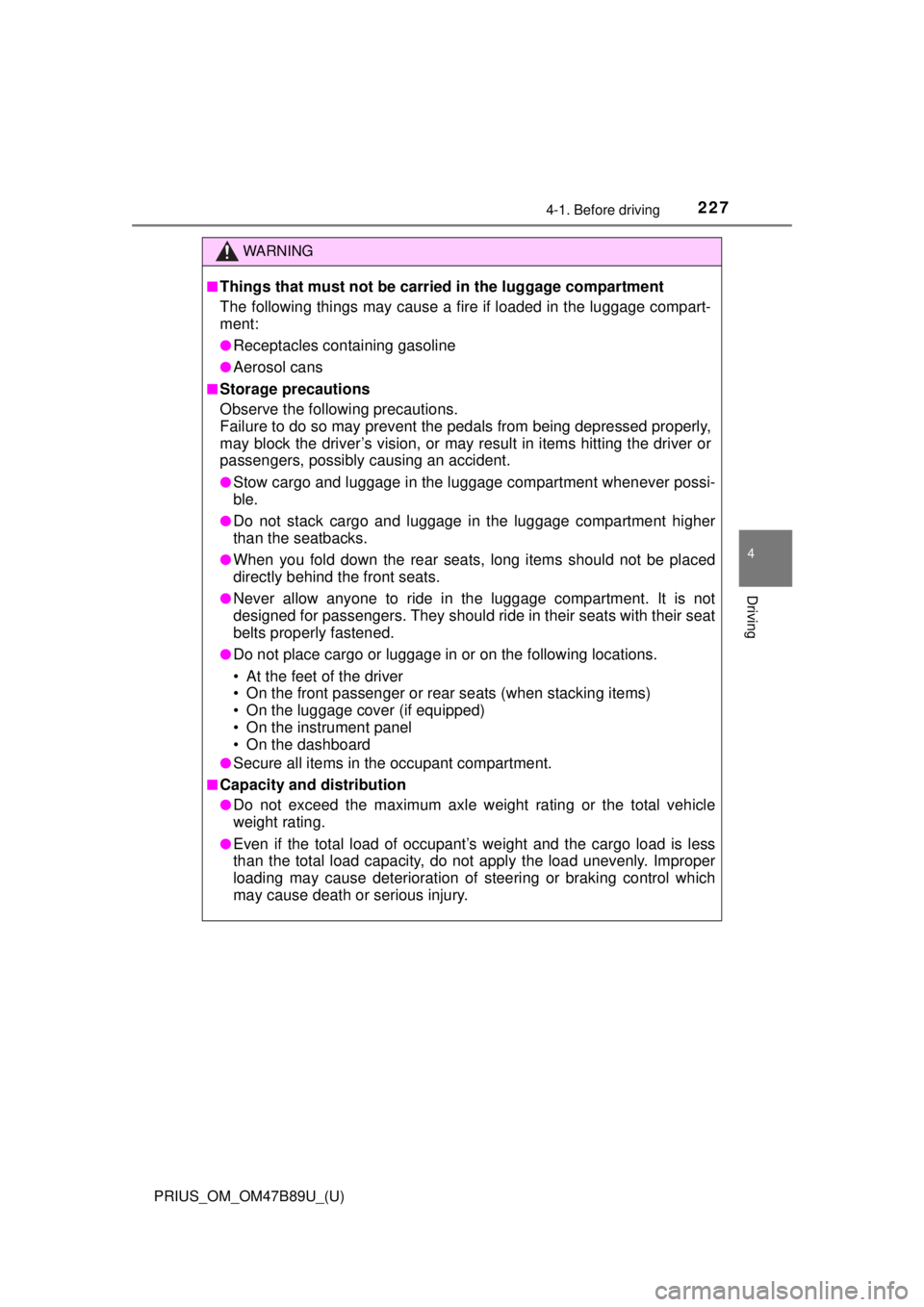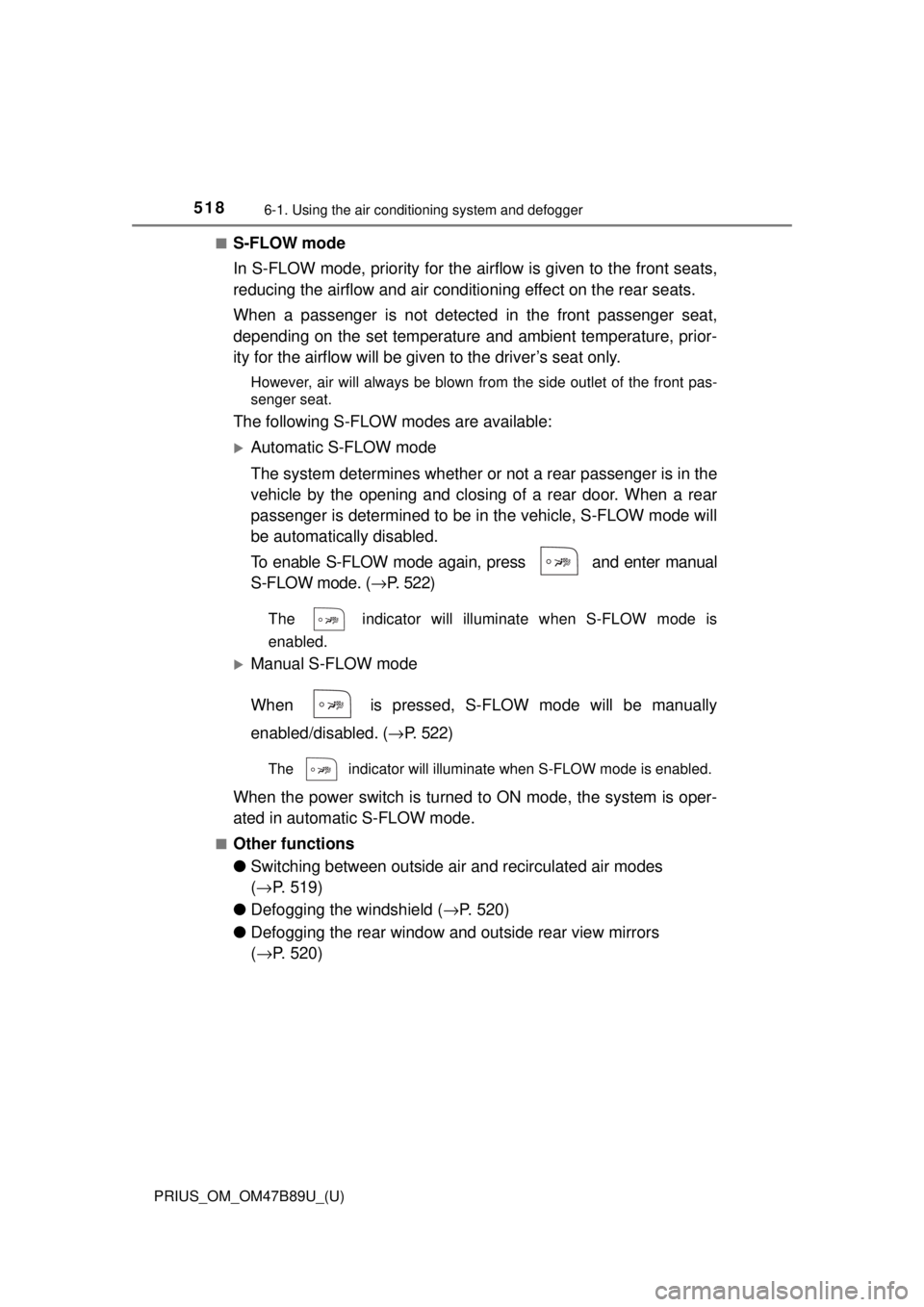Page 194 of 820
194
PRIUS_OM_OM47B89U_(U)
3-3. Adjusting the seats
WARNING
■After returning the seatback to the upright position
Observe the following precautions. Failure to do so may result in death or
serious injury.
● Check that the seat belts are not twisted or caught in the seatback.
●Make sure that the seatback is securely
locked in position by lightly pushing it
back and forth.
If the seatbacks is not securely locked,
the red marking will be visible on the
seatback lock release lever. Make sure
that the red marking is not visible.
Page 195 of 820
195
PRIUS_OM_OM47B89U_(U)
3-3. Adjusting the seats
3
Operation of each component
Head restraints
Up
Pull the head restraints up.
Down
Push the head restraint down while
pressing the lock release button.
■
Rear outboard seats To f o l d
Pull the head restraint up while
pressing the lock release button.
To u s e
Lift up and push down the head
restraint to the lowest lock posi-
tion.
■
Rear center seat Up
Pull the head restraints up.
Down
Push the head restraint down
while pressing the lock release
button.
Head restraints are provided for all seats.
Front seats
Lock release button
1
2
Rear seats
Lock release button
1
2
Lock release button
1
2
Page 196 of 820
196
PRIUS_OM_OM47B89U_(U)
3-3. Adjusting the seats
■Removing the head restraints
Front and rear center seats
Rear outboard seats
■ Installing the head restraints
Front and rear center seats
Rear outboard seats
Pull the head restraint up while pressing
the lock release button.
Pull the head restraint up while pressing
the lock release buttons.
Align the head restraint with the installa-
tion holes and push it down to the lock
position.
Press and hold the lock release button
when lowering the head restraint.
Align the head restraint with the installa-
tion holes and push it down to the lowest
lock position.
Lock release button
Lock release buttons
Lock release button
Page 197 of 820
PRIUS_OM_OM47B89U_(U)
1973-3. Adjusting the seats
3
Operation of each component
■Adjusting the height of the head restraints (front seats)
■ Adjusting the rear cente r seat head restraint
Always raise the head restraint one level from the stowed position when
using. Make sure that the head restraints are
adjusted so that the center of the head
restraint is closest to the top of your ears.
WARNING
■ Head restraint precautions
Observe the following precautions regarding the head restraints. Failure to
do so may result in death or serious injury.
● Use the head restraints designed for each respective seat.
● Adjust the head restraints to the correct position at all times.
● After adjusting the head restraints, push down on them and make sure
they are locked in position.
● Do not drive with the head restraints removed.
Page 227 of 820

PRIUS_OM_OM47B89U_(U)
2274-1. Before driving
4
Driving
WARNING
■Things that must not be carried in the luggage compartment
The following things may cause a fire if loaded in the luggage compart-
ment:
●Receptacles containing gasoline
●Aerosol cans
■Storage precautions
Observe the following precautions.
Failure to do so may prevent the pedals from being depressed properly,
may block the driver’s vision, or may result in items hitting the driver or
passengers, possibly causing an accident.
●Stow cargo and luggage in the luggage compartment whenever possi-
ble.
●Do not stack cargo and luggage in the luggage compartment higher
than the seatbacks.
●When you fold down the rear seats, long items should not be placed
directly behind the front seats.
●Never allow anyone to ride in the luggage compartment. It is not
designed for passengers. They should ride in their seats with their seat
belts properly fastened.
●Do not place cargo or luggage in or on the following locations.
• At the feet of the driver
• On the front passenger or rear seats (when stacking items)
• On the luggage cover (if equipped)
• On the instrument panel
• On the dashboard
●Secure all items in the occupant compartment.
■Capacity and distribution
●Do not exceed the maximum axle weight rating or the total vehicle
weight rating.
●Even if the total load of occupant’s weight and the cargo load is less
than the total load capacity, do not apply the load unevenly. Improper
loading may cause deterioration of steering or braking control which
may cause death or serious injury.
Page 518 of 820

5186-1. Using the air conditioning system and defogger
PRIUS_OM_OM47B89U_(U)■
S-FLOW mode
In S-FLOW mode, priority for the ai
rflow is given to the front seats,
reducing the airflow and air conditio ning effect on the rear seats.
When a passenger is not detecte d in the front passenger seat,
depending on the set temperature and ambient temperature, prior-
ity for the airflow will be gi ven to the driver’s seat only.
However, air will always be blown from the side outlet of the front pas-
senger seat.
The following S-FLOW modes are available:
Automatic S-FLOW mode
The system determines whether or not a rear passenger is in the
vehicle by the opening and closing of a rear door. When a rear
passenger is determined to be in the vehicle, S-FLOW mode will
be automatically disabled.
To enable S-FLOW mode again, press and enter manual
S-FLOW mode. (→P. 522)
The indicator will illuminate when S-FLOW mode is
enabled.
Manual S-FLOW mode
When is pressed, S-FLOW mode will be manually
enabled/disabled. ( →P. 522)
The indicator will illuminate when S-FLOW mode is enabled.
When the power switch is turned to ON mode, the system is oper-
ated in automatic S-FLOW mode.
■Other functions
● Switching between outside ai r and recirculated air modes
( → P. 519)
● Defogging the windshield ( →P. 520)
● Defogging the rear window and outside rear view mirrors
(→ P. 520)
Page 528 of 820

5286-1. Using the air conditioning system and defogger
PRIUS_OM_OM47B89U_(U)■
S-FLOW mode
In S-FLOW mode, priority for the ai
rflow is given to the front seats,
reducing the airflow and air conditio ning effect on the rear seats.
When a passenger is not detecte d in the front passenger seat,
depending on the set temperature and ambient temperature, prior-
ity for the airflow will be gi ven to the driver’s seat only.
However, air will always be blown from the side outlet of the front pas-
senger seat.
The following S-FLOW modes are available:
Automatic S-FLOW mode
The system determines whether or not a rear passenger is in the
vehicle by the opening and closing of a rear door. When a rear
passenger is determined to be in the vehicle, S-FLOW mode will
be automatically disabled.
To enable S-FLOW mode again, press and enter manual
S-FLOW mode. (→P. 532)
The indicator will illuminate when S-FLOW mode is enabled.
Manual S-FLOW mode
When is pressed, S-FLOW m ode will be manually enabled/
disabled. ( →P. 532)
The indicator will illuminate when S-FLOW mode is enabled.
When the power switch is turned to ON mode, the system is oper-
ated in automatic S-FLOW mode.
■Other functions
● Switching between outside ai r and recirculated air modes
( → P. 529)
● Defogging the windshield ( →P. 530)
● Defogging the rear window and outside rear view mirrors
(→ P. 530)
Page 536 of 820
536
PRIUS_OM_OM47B89U_(U)
6-1. Using the air conditioning system and defogger
Seat heaters∗
∗: If equipped
Seat heaters heat the front seats.
WARNING
●Care should be taken to prevent injury if anyone in the following categories
comes in contact with the seats when the heater is on:
• Babies, small children, the elderly, the sick and the physically chal-
lenged
• Persons with sensitive skin
• Persons who are fatigued
• Persons who have taken alcohol or drugs that induce sleep (sleeping drugs, cold remedies, etc.)
● Observe the following precautions to prevent minor burns or overheating:
• Do not cover the seat with a blanket or cushion when using the seat heater.
• Do not use seat heater more than necessary.
NOTICE
● Do not put heavy objects that have an uneven surface on the seat and do
not stick sharp objects (needles, nails, etc.) into the seat.
● To prevent 12-volt battery discharge, do not use the functions when the
hybrid system is off.